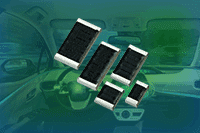source: Vishay news
MALVERN, Pa. — Jan. 17, 2018 — Vishay Intertechnology, Inc. (NYSE: VSH) today introduced a new series of AEC-Q200 qualified, medium voltage thick film chip resistors. Designed to save space and lower component counts in automotive and industrial applications, Vishay Techno CRMA series devices offer high working voltages up to 1415 V in five compact case sizes ranging from 1206 to 2512.
The devices released today deliver higher voltage capabilities than standard thick film chip resistors. This makes them ideal for battery management and overvoltage protection in electric vehicles, and voltage monitoring and regulation in power inverters, high voltage power supplies, defibrillators, and smart circuit breakers.
CRMA series resistors offer a wide resistance range from 150 Ω to 75 MΩ, tolerances down to ± 0.5 %, temperature coefficients of ± 100 ppm/°C, and power ratings from 0.30 W to 1.0 W. The devices are available with solder-coated nickel barrier or solder-coated non-magnetic terminations in three-side wraparound or top-only flip chip configurations.
Device Specification Table:
| Part # | Case size | P70 °C (W) | Max. Working voltage (V) | Resistance range (Ω) |
|---|---|---|---|---|
| CRMA1206 | 1206 | 0.30 | 550 | 150 15 M |
| CRMA1210 | 1210 | 0.35 | 650 | 300 to 20 M |
| CRMA2010 | 2010 | 0.50 | 895 | 500 to 40 M |
| CRMA2510 | 2510 | 0.80 | 1265 | 1 k to 60 M |
| CRMA2512 | 2512 | 1.0 | 1415 | 1 k to 75 M |
Samples and production quantities of the CRMA series are available now, with lead times of 8 to 10 weeks.































